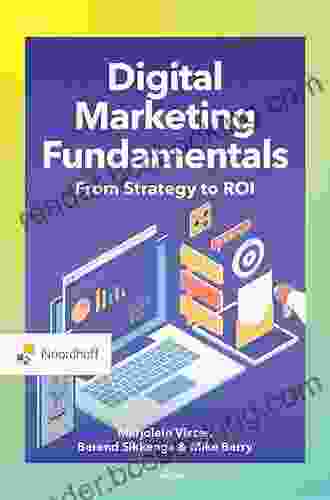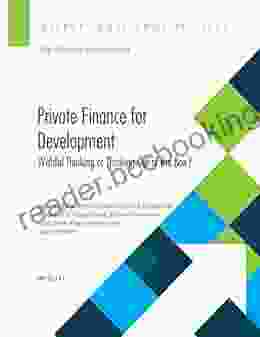Unlocking Financial Empowerment: A Comprehensive Guide to Private Finance for Development

5 out of 5
| Language | : | English |
| File size | : | 6075 KB |
| Text-to-Speech | : | Enabled |
| Screen Reader | : | Supported |
| Enhanced typesetting | : | Enabled |
| Word Wise | : | Enabled |
| Print length | : | 276 pages |
The world is facing unprecedented challenges, from climate change to poverty and inequality. To address these complex issues, we need innovative and sustainable solutions. Private finance for development has emerged as a powerful tool to drive transformative change and create a more equitable and prosperous future.
This article aims to provide a comprehensive overview of private finance for development. We will explore the fundamental principles, innovative approaches, and real-world case studies that demonstrate the transformative power of this approach. By understanding the key concepts and successful implementation strategies, we can harness the potential of private finance to drive sustainable development and empower communities around the world.
Understanding Private Finance for Development
Private finance for development refers to the use of private sector resources to support economic and social development projects. This can take various forms, including equity investments, loans, and guarantees.
The primary goal of private finance for development is to mobilize private capital to address critical development challenges. By leveraging the expertise, innovation, and financial resources of the private sector, we can accelerate progress towards sustainable development goals and create a more inclusive and equitable world.
Principles of Private Finance for Development
Effective private finance for development is guided by several key principles:
- Alignment with Development Goals: Private finance projects should be aligned with national and international development priorities, such as poverty reduction, environmental protection, and economic growth.
- Financial Viability: Projects should be financially sustainable, ensuring that they can generate sufficient revenue to cover costs and attract private investment.
- Risk Management: Private finance for development projects often involves managing complex risks. It is crucial to conduct thorough risk assessments and develop appropriate mitigation strategies.
- Transparency and Accountability: Private finance projects should be transparent and accountable to stakeholders, including governments, communities, and investors.
- Local Ownership: Successful private finance for development projects involve local communities and stakeholders in the planning and implementation process, ensuring that projects are aligned with local needs and priorities.
Innovative Approaches to Private Finance for Development
The field of private finance for development is constantly evolving, with innovative approaches emerging to address complex challenges. Some of the most promising approaches include:
- Blended Finance: Blended finance combines public and private funds to support development projects that are considered too risky for private investment alone. This approach can leverage public resources to de-risk projects and attract private capital.
- Impact Investing: Impact investing refers to investments that aim to generate both financial returns and measurable social or environmental impact. This approach aligns private sector incentives with development goals.
- Digital Finance: Digital technologies are revolutionizing the delivery of financial services, particularly in underserved communities. Digital finance can increase access to financial services, reduce transaction costs, and promote financial inclusion.
- Green Finance: Green finance focuses on financing projects that contribute to environmental sustainability. This includes investments in renewable energy, energy efficiency, and climate adaptation measures.
Case Studies of Successful Private Finance for Development Projects
Numerous successful private finance for development projects have demonstrated the transformative power of this approach. Here are two notable case studies:
Case Study: Private Infrastructure Development in India
India faces a significant infrastructure gap, which hampers economic growth and social development. Private finance has played a crucial role in addressing this challenge.
The government of India has implemented a Public-Private Partnership (PPP) model to attract private investment in infrastructure projects. Under this model, private companies partner with the government to develop and operate infrastructure assets, such as roads, bridges, and airports.
One successful example is the Delhi-Mumbai Industrial Corridor (DMIC). This massive infrastructure project is being developed through a PPP model, with private companies investing in various sectors, including transportation, energy, and manufacturing.
The DMIC project is expected to create millions of jobs, boost economic growth, and improve connectivity in India. It demonstrates the potential of private finance to address critical infrastructure needs and drive sustainable development.
Case Study: Impact Investing in Education in Kenya
Education is a key driver of economic and social progress. In Kenya, private finance has been used to support innovative education initiatives that are addressing critical challenges.
The Bridge International Academies (BIA) is a leading provider of low-cost private schools in Kenya. BIA has developed a scalable model that provides affordable, high-quality education to students from low-income families.
Impact investors have recognized the potential of BIA's model to address the education gap in Kenya. They have provided funding to support BIA's expansion and ensure its long-term sustainability.
The BIA case study highlights the role of impact investing in driving social change. By aligning private sector incentives with development goals, we can create innovative solutions to tackle complex challenges.
Private finance for development is a powerful tool to drive transformative change and create a more equitable and prosperous future. By understanding the fundamental principles, innovative approaches, and successful case studies, we can harness the potential of private capital to address critical development challenges.
As we move forward, it is essential to continue exploring innovative ways to mobilize private finance for development. By fostering collaboration between governments, the private sector, and civil society, we can create a more inclusive and sustainable world for all.
Additional Resources:
- World Bank: Private Finance for Development
- IFC: Private Finance for Development
- UNDP: Private Finance for the SDGs
5 out of 5
| Language | : | English |
| File size | : | 6075 KB |
| Text-to-Speech | : | Enabled |
| Screen Reader | : | Supported |
| Enhanced typesetting | : | Enabled |
| Word Wise | : | Enabled |
| Print length | : | 276 pages |
Do you want to contribute by writing guest posts on this blog?
Please contact us and send us a resume of previous articles that you have written.
 Book
Book Novel
Novel Page
Page Chapter
Chapter Text
Text Story
Story Genre
Genre Reader
Reader Library
Library Paperback
Paperback E-book
E-book Magazine
Magazine Newspaper
Newspaper Paragraph
Paragraph Sentence
Sentence Bookmark
Bookmark Shelf
Shelf Glossary
Glossary Bibliography
Bibliography Foreword
Foreword Preface
Preface Synopsis
Synopsis Annotation
Annotation Footnote
Footnote Manuscript
Manuscript Scroll
Scroll Codex
Codex Tome
Tome Bestseller
Bestseller Classics
Classics Library card
Library card Narrative
Narrative Biography
Biography Autobiography
Autobiography Memoir
Memoir Reference
Reference Encyclopedia
Encyclopedia Ortrun Egelkraut
Ortrun Egelkraut Sheila Watt Cloutier
Sheila Watt Cloutier The Law Store
The Law Store Stuart Mcrobert
Stuart Mcrobert N Gregory Mankiw
N Gregory Mankiw William Edwin Baxter
William Edwin Baxter Kirk Mcdonough
Kirk Mcdonough William A Birdthistle
William A Birdthistle Michael Lewrick
Michael Lewrick Paul Cornell
Paul Cornell Robert Scheyer
Robert Scheyer Laura Ray
Laura Ray Toni Patrick
Toni Patrick Liz Climo
Liz Climo Kris Radish
Kris Radish Valerie Wilson Wesley
Valerie Wilson Wesley Nicole Howard
Nicole Howard Um A Yube
Um A Yube Vivian S Lee
Vivian S Lee Marcia Sewall
Marcia Sewall
Light bulbAdvertise smarter! Our strategic ad space ensures maximum exposure. Reserve your spot today!

 William WordsworthUnveil the Horrors of the French Revolution in "An Episode Under the Terror"
William WordsworthUnveil the Horrors of the French Revolution in "An Episode Under the Terror"
 Mikhail BulgakovCommunicating Fashion: Deciphering the Language of Style, Clothing, and Media
Mikhail BulgakovCommunicating Fashion: Deciphering the Language of Style, Clothing, and Media Hassan CoxFollow ·15.6k
Hassan CoxFollow ·15.6k Hank MitchellFollow ·11.7k
Hank MitchellFollow ·11.7k Truman CapoteFollow ·8.1k
Truman CapoteFollow ·8.1k Arthur Conan DoyleFollow ·15.1k
Arthur Conan DoyleFollow ·15.1k Mark TwainFollow ·13.9k
Mark TwainFollow ·13.9k Phil FosterFollow ·5.1k
Phil FosterFollow ·5.1k Kenneth ParkerFollow ·3.1k
Kenneth ParkerFollow ·3.1k Neil ParkerFollow ·18.7k
Neil ParkerFollow ·18.7k

 Liam Ward
Liam WardUnleash the Power of Goblin Slayer: Discover the Gripping...
Enter the Shadowy Realm of...

 Eli Brooks
Eli BrooksWalking the Territory: Your Essential Companion for...
Adventure Awaits! Prepare to immerse yourself...

 Floyd Richardson
Floyd RichardsonGoblin Slayer: A Gripping Light Novel Series That Will...
Step into the shadowy...

 Dennis Hayes
Dennis HayesFrom Strategy to ROI: The Ultimate Guide to Driving...
In the dynamic and competitive business...

 Edward Reed
Edward ReedUnveiling the Rich Tapestry of Tennis in Britain: A...
: Tennis - A British Love Affair Tennis, a...

 Michael Crichton
Michael CrichtonEscape into the Thrilling World of "Here and Now" by...
In the tapestry...
5 out of 5
| Language | : | English |
| File size | : | 6075 KB |
| Text-to-Speech | : | Enabled |
| Screen Reader | : | Supported |
| Enhanced typesetting | : | Enabled |
| Word Wise | : | Enabled |
| Print length | : | 276 pages |








